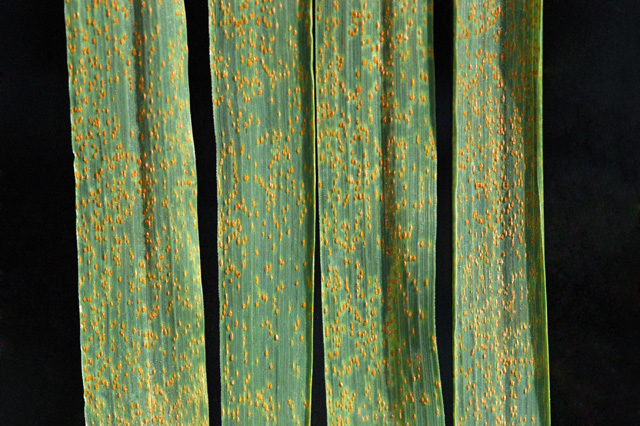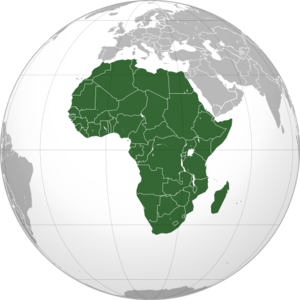Modelling Plant Disease
Interview with
Ben - It's estimated that the worldwide cost of crop disease is at least 200 billion dollars and that 10% of crop yield per year is lost to disease. For financial and humanitarian reasons therefore, it's obviously very important to find ways to control plant diseases. And to help us do that, we need to understand how diseases develop and spread. And for that, we rely partly on mathematical models. We're joined by Chris Gilligan, Professor of Mathematical Biology in the Department of Plant Sciences at Cambridge University. Chris, thank you ever so much for joining us and just to get a handle on this, what is the extent of plant disease say, compared with human disease?
Chris - Well, let me answer that by recounting, I've just been to Kenya to have a look at what's happening there. And there, we have a number of diseases which are really very, very serious. So take for example, wheat which is a staple crop throughout the world. There is a very serious new strain of disease that is developing on wheat within Africa and is now spreading potentially worldwide. All of wheat worldwide is potentially susceptible to this particular disease. At the same trip, I also looked at the  cassava diseases, where cassava is a very staple part of diets in large parts of Africa also, in South America and elsewhere. And two various diseases are really threatening the yield of this important staple crop, so they're extremely threatening.
cassava diseases, where cassava is a very staple part of diets in large parts of Africa also, in South America and elsewhere. And two various diseases are really threatening the yield of this important staple crop, so they're extremely threatening.
Ben - Could this be a worldwide problem especially because there are lots of crops where we have sold the best cultivar all over the world. And so genetically, there's not actually as much variety from one country to the next, as you would expect if they had naturally spread.
Chris - That's right. So, the job of plant breeders is to produce new varieties which are high yielding and also which are resistant to pests and diseases. If you have something that is working successfully, needless to say, everybody wants to have that. And so, there is a very strong driver - when you do have a successful variety for it to be widely grown. And that's exactly what has happened with wheat stem rust, the disease that I introduced briefly before, which has been controlled successfully for more than 30 years by essentially the same varieties but now, with a new strain arising. Essentially that strain is confronted with genetic homogeneity and so can spread very rapidly.
Ben - I've always heard that Cavendish bananas, the popular bright yellow banana that we get, that they're all essentially clones as well.
Chris - That's right and that's a very unstable situation in which to be in. And modern plant breeding, and modern epidemiology is actually looking very carefully at how we can increase the heterogeneity that is the variability in the types of cultivars that we're growing and then the real challenge is to work out what's the spatial distribution that one should have within a country, and then thinking worldwide in order to minimize the risk of disease spreading.
Ben - So, how do we go about modelling these diseases and what scales can we look at it? Can we do a worldwide model or do we have to keep to something a bit more regional?
Chris - Needless to say, we can do both but in essence what one does is look at - the particular region that one is interested in which may be a country and then look at - is the spread from country to country, that's known as spread in a metapopulation where a metapopulation essentially two subpopulations with epidemics occurring in each country, and then some reinforcement of movement of what we call an inoculum which is the material that gives rise to the disease from one country to another. The challenge is in deciding how we can set about using mathematical models to predict first of all, the spread of disease and secondly, then choose the models to optimise strategies for control is really - you're looking at a very messy system.
 You don't have very much information as the new pathogen arises. And so, what you're attempting to do is to get the signature for the spread of the epidemic. That's the signature of how does it spread over space and over time. To do that, we produced some maps though the maps are usually incomplete and then use some various statistical accounts, sometimes complicated statistical methods to identify really who infected whom or what infected what, and from that, one can then identify some of the key parameters that were influential in the spread of the disease.
You don't have very much information as the new pathogen arises. And so, what you're attempting to do is to get the signature for the spread of the epidemic. That's the signature of how does it spread over space and over time. To do that, we produced some maps though the maps are usually incomplete and then use some various statistical accounts, sometimes complicated statistical methods to identify really who infected whom or what infected what, and from that, one can then identify some of the key parameters that were influential in the spread of the disease.
Ben - I assume you can't just look at the species - you're looking at both species of pathogens, species of plants, and geography. You also have to look at other things like; the invasive species, reservoirs, the way that humans move plants around. There must be an awful lot to try and fit into those models.
Chris - The art of modelling is really to identify what is essential and to ignore what is not essential. So as soon as I talk to an expert who works on a particular disease or a particular crop, they can easily fill three pages of notes as to what ought to be important. As a modeller, I am not going to try and model three pages of notes worth of complicated potential interactions. What I do is identify what are the key processes and I indicated that the spread is very important, the transmissibility, so when the pathogen (which is the organism that causes disease) when that lands on a host, what's the chance that it can infect the host? You mentioned that there are different forms of spread. There may be hundreds of different forms of spread but the beauty of approaching this from a statistical and mathematical perspective is that these can be usually separated into one or two scales.
Ben - So, once we have our models - once you put all of this together, how can you actually use that to help predict or control, or put activities into place that will stop the spread of disease?
Chris - So having got the model, we've identified what we believe is responsible for the spread and that enables us then to predict future spread. There are another two directions in which one can go, the fastest to produce risk map which is saying, where's the disease most likely to spread to. Secondly, one may also produce what we call hazard maps, where hazard map is saying, if the disease were to enter a particular area - so for example, the wheat example I gave you before, has now spread from Africa through into Iran. What if it were to get into the Indian subcontinent, where will it spread most rapidly? And that's the function of a hazard map. Having got those risks and hazard maps, the next thing to do is to say; let's think about what methods we have for control which could be the deployment of chemicals but there won't be enough chemicals to apply everywhere. It could be the development of new resistant varieties and again, there won't be enough to apply everywhere initially. How do we optimise where we place those so that we minimise the risks of spread of the disease? And that's where the modelling helps because you run many of these 'what if'scenarios often taking and always indeed taking account of uncertainties because we don't know everything about the pathogen.
Ben - So these models should help us to make the intelligent decisions about what to do and about what do to with limited resources. Thank you ever so much. That's Professor Chris Gilligan from Cambridge University. And he will be with us for the rest of show so if you have any questions for him, then do please get in touch.




Comments
Add a comment